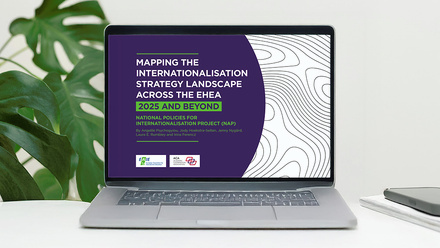The employability dimension in joint programmes

Europe has been a global leader in the development of joint and collaborative programmes, and the Summer 2022 issue of EAIE Forum magazine takes a deeper dive into this key aspect of international higher education. Kicking off the launch of the latest edition of Forum, today’s blog post by the Chair of the EAIE Expert Community European Collaborative Programmes takes a deep dive into the relationship between joint programmes and employability outcomes.
Employability is not only about the acquisition of a job, but instead is "[…] the ability to gain initial employment, to maintain employment and to be able to move around within the labour market," as stated by the Bologna Follow-up Group. Since the early 1990s, universities have been developing international Joint Programmes (JPs), but little evidence of their added value in terms of employability and efficiency has been produced.
What is the impact of JPs on graduates’ life and career, what are the motivations for students to enrol in JPs, to what extent are employers involved in the development and implementation of JPs, and what lessons can universities learn from the stakeholders’ feedback to develop more efficient international JPs leading to enhanced employability? The REDEEM (2015–2017) and REDEEM 2 (2018–2021) projects carried out a number of studies and surveys with the objective of providing answers to these questions.
Institutional survey
Out of the 450 universities that responded to the institutional survey, only 17% stated that they offer JPs with the direct participation of companies. Although the figures in this sense are quite low in all investigated countries, the situation varies a lot from country to country, from 50% of Italian HEIs claiming to offer JPs with the direct participation of employers, down to 18% in Germany and 15% in non-EU countries. Most of the EU countries (other than Italy, Sweden, Belgium, France and Germany) showed an average employer participation of a mere 5%.
The 17% of the respondents with ongoing JPs with the participation of employers were asked about the nature of this involvement and their answers showed that in many cases this is very superficial and produces a very limited impact. The most common activity is field visits to the employers (73% of respondents), followed by curricular internships (69%), and hosting students for the Master’s thesis (69%). Only one third of the respondents mentioned joint curriculum development as one of the activities carried out together with the employers.
Only 17% of HEIs stated that they offer joint programmes with the direct participation of companies
The respondents with experience in this type of JPs were also asked about the perceived benefits from such involvement. As for the development of JPs in general, the main rationale seems to be the direct benefit of the HEI, with 46% of the respondents mentioning "tighter collaboration with the involved companies" and 31% selecting "higher recruitment capacity" (attractiveness of the JP) as the main result. 38% of the respondents mentioned "higher quality of the JP" achieved through the involvement of the employers. Only 23% of the respondents experienced a financial contribution by the employers involved, and only 8% stated that this involvement resulted in a higher sustainability of the JP.
When asked for the reasons that prevented the involvement of companies, the majority of the respondents mentioned "lack of experience in developing JPs with the direct involvement of employers" as the main obstacle and 21% the "lack of interest from the employer’s side". Only 10% of the respondents consider legal issues to be an obstacle and even fewer mentioned lack of staffing or lack of time on the company side as major concerns.
Alumni survey
A number of figures show the actual added value of the employability of JPs when compared to single degrees (SD):
- 90.0% of the JP alumni and 84.8% of the SD alumni are employed;
- 67.8% of the JP graduates and only 28.2% of the SD graduates work outside of their home country;
- 69.1% of the JP alumni and 59.7% of the SD graduates work at large companies (> 250 employees);
- 59.7% of the JP graduates and 72.7% of the SD alumni work in the private sector;
- 30.6% of the JP graduates and 20.9% of the SD alumni work in professional, scientific and technical fields.
When comparing the country of origin (country of upper secondary education) with the country in which the JP graduates are working, there are clear signs of a shift from South and East towards North and West. This is also reflected by the results of the focus groups: students from lower-income countries tend to enrol in JPs with the explicit objective of earning a degree that will possibly allow them to be competitive in the labour market of countries with higher income prospects. On the contrary, students from higher-income countries tend to enrol in JPs for reasons more related to their personal growth and for the experience in itself.
When comparing how related the graduates’ jobs are to their fields of study, with 1 being not related and 5 totally related, the correlation is highest for JP alumni who worked in Central Asia (JP 4.3 vs SD 3.0), Eastern Europe (JP 4.2 vs SD 3.8), and North America (4.2 vs SD 3.9). Even if to a lower extent, JP graduates from South America, Northern Europe, and Western Europe also reported a higher correlation than their SD peers.
Living in a different country during the studies (4.6), interacting with new cultures (4.3), experiencing a different education/academic environment and access to more job opportunities (4.2) were the main reasons to enrol in a JP. "Better prospects to get the job or jobs I desire" was highly ranked by JP alumni (4.1) compared to the answers provided by the SD alumni (3.4). The same is true for "Increasing the opportunities for a career in country other than that of my origin" (JP 4.1 vs SD 3.6), and "Better salary prospects" (JP 3.3 vs SD 2.6).
Conclusions
Companies still ignore the added value of JPs, but when asked about the ideal profile of the applicants they mention features that the JP graduates list when asked about the added value of graduating from a JP. Universities and companies have often different perspectives on employability: training future PhD students vs training problem solvers for urgent, short-term, practical challenges.
When asked about the ideal profile of applicants, companies mention the same features that graduates list when asked about the added value of graduating from a JP
Direct involvement of companies in JPs is considered as crucial by students, alumni and employers, but HEIs still do little in this sense. As the articles in this edition of EAIE Forum magazine illustrate from a variety of perspectives, there are increasingly more mechanisms available for pursuing joint programmes, and universities should engage all stakeholders – including employers – to ensure their sustainability and impact. onal agencies have long been supporting students in seeking overseas education. While some higher education institutions have had negative experiences, other colleges and universities around the world have found benefits from collaborating with them. In the aftermath of the COVID-19 global pandemic, perhaps we can break the stigma and imagine more institutions recruiting the majority of international students through education agents to maximise financial efficiencies and recruitment enrolment targets.






